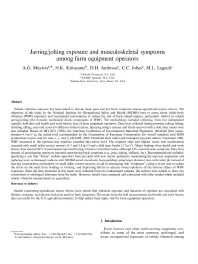Mining Publication: Jarring/Jolting Exposure and Musculoskeletal Symptoms among Farm Equipment Operators
Original creation date: September 2008
Vehicle vibration exposure has been linked to chronic back pain and low-back symptoms among agricultural tractor drivers. The objectives of this study by the National Institute for Occupational Safety and Health (NIOSH) were to assess driver whole-body vibration (WBV) exposures and recommend interventions to reduce the risk of back-related injuries, particularly relative to vehicle jarring/jolting (the transient mechanical shock components of WBV). The methodology included collecting, from two independent samples, field data and health and work history data of farm equipment operators. Data were collected during mowing, raking, baling, chiseling, tilling, and road travel for different model tractors. Spraying using a sprayer and shrub removal with a skid-steer loader were also included. Based on ISO 2631 (1985), the American Conference of Governmental Industrial Hygienists, threshold limit values, presents 0.5 m/s2 as the action level recommended by the Commission of European Communities for overall weighted total RMS acceleration (vector sum for axes x, y, and z) [ACGIH, 2006. Threshold limit values and biological exposure indices. Cincinnati, OH]. WBV measured at the operator/seat interface exceeded this action level. The roughest rides and highest vector sum accelerations occurred with small utility tractor mowers (3.3 and 2.8 m/s2) and a skid-steer loader (1.7 m/s2). Major findings from health and work history data showed 96% of participants reported having to bend or twist their necks, although 24% reported neck symptoms. Sixty-four percent of participating operators reported experiencing back symptoms (e.g., pain, aching, stiffness, etc.). Recommendations included: specifying a seat that "better" isolates operators from jars/jolts with new tractor purchases; maintaining the seat/seat suspension and replacing worn or damaged cushions with NIOSH tested viscoelastic foam padding; using larger diameter tires with radial-ply instead of bias-ply construction, particularly on small utility tractor-mowers, to aid in attenuating ride "roughness"; using a swivel seat to reduce the stress on the neck from bending or twisting; and improving efforts to educate owner/operators of the adverse effects of WBV exposures. Since the data presented in this paper were collected from two independent samples, the authors were unable to draw any correlations or etiological inferences from the study. However, results were compared and contrasted with other studies which included similar vibration measurements in agriculture.
Authors: AG Mayton, NK Kittusamy, DH Ambrose, CC Jobes, M Legault
Peer Reviewed Journal Article - September 2008
NIOSHTIC2 Number: 20034405
Int J Ind Ergon 2008 Sep; 38(9-10):758-766
See Also
- Determination of Sound Exposures (DOSES): Software Manual and Implementation Guide
- Hearing Loss Prevention in Mining - 2005
- Physical Strength Assessment in Ergonomics
- Proceedings of the First American Conference on Human Vibration
- Systematic Comparison of Different Seats on Shuttle Cars Used in Underground Coal Mines
- Technology News 536 - NIOSH Develops New Software to Analyze and Reduce Noise Exposure
- Technology News 538: Acoustic Enclosure to Reduce Noise From Vibrating Screen Mechanism Housings
- Technology News 539 - Identifying The Benefits Of Engineering Noise Controls Through A Business Case
- Whole-Body Vibration and Postural Stress among Operators of Construction Equipment: A Literature Review
- Whole-Body Vibration Exposure Comparison of Seat Designs for Low- and Mid-Seam Shuttle Cars in Underground Coal Mines
- Content source: National Institute for Occupational Safety and Health, Mining Program


 ShareCompartir
ShareCompartir
